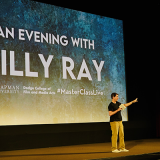Polaroids flash back to the past in Fullerton
August 7, 2009
By RICHARD CHANG
The Orange County Register
Click here to see photos of the Polaroid exhibit in Fullerton
Click here to see examples of how Polaroid pictures have been used in pop culture

Remember the fun you used to have with Polaroid pictures?
Pressing the red button, hearing the automated buzz as the squarish, white-bordered picture came out, and waiting for the image to develop – from a green wall to various colors and details forming before your very eyes.
It was kind of like magic.
Polaroids were fun at parties and family gatherings. They were accessible and fast. You didn't need to be a professional photographer to take them. Yet they offered a unique, one-of-a-kind image at any given instance.
"It was your easy, quick camera, and it captured that moment," said Kevin Staniec, who with some friends and colleagues has organized an exhibit in Fullerton of hundreds of Polaroid pictures. "You got the pictures right there in your hand. Anybody could take a beautiful picture, if they saw something beautiful."
Yet, time has not been kind to Polaroids. The cameras and film have been overtaken by one-hour photo labs, digital cameras and cell phone technology. Being able to see a picture immediately on a digital camera or cell phone screen, then print it at home, doomed the whole quirky line of instant cameras and film.
In fact, the Polaroid Corporation filed for bankruptcy twice this decade, and the company stopped making its instant film and cameras last year. The last packages of Polaroid's 600 series film are due to expire this month.
But these cold, hard facts haven't deterred Staniec, a Chapman University film graduate, and hundreds of photographers who have submitted work to the show. "Instant Gratification: A Polaroid Party" features about 1,200 images from all over the county and world. The group show at Hibbleton Gallery in downtown Fullerton opens this weekend and continues through Aug. 30.
Organizers have lined the walls – from ceiling to floor – of the modest, one-room gallery with the classic, 3�- by 4�-inch Polaroid pictures. Some of them are portraits of family and friends; some are snapshots of pets and complete strangers; others are landscapes, cityscapes, sky shots and pictures of foreign travels. A number have text written on them. A few have been enhanced with drawings, paint and other alterations.
"I definitely think the crowd (of photographers) we're getting shows that a lot of people who shoot Polaroids come from totally different walks of life," said Staniec, who also serves as creative director for the Orange County-based magazine ISM. "People started learning little techniques to cheat it and play with the emulsion. Depending on who and where you're shooting, it creates this atmosphere that almost looks surreal."
Jerry Burchfield, a longtime Orange County photographer and retired professor of photography at Cypress College, says he loves Polaroids and has shot hundreds of instant images. They have a certain appearance, he says, that you just can't imitate or replace.
"It definitely has a nostalgic element," he said. "I found it very useful when I traveled, encountering people in far-off places. It would open doors and create dialogue."
Over the years, many other photographers and artists have cherished the product's simultaneously accessible and unusual properties. Artists such as Lucas Samaras, Les Krims, David Hockney, Barbara Kasten and John Reuter have played with Polaroids' exposure, emulsion and color.
"As an art product, it still is extremely unique," Burchfield said. "I think that's where the real loss will be felt, is the uniqueness of the product and how artists were able to work with it. Unfortunately, the art market isn't large enough to warrant keeping something like that going."
SYMBOLS OF A BYGONE ERA
In addition to their aesthetic possibilities, Polaroids represent a certain era in American culture and history, a time when progress and inventions were driving the national psyche.
"It's somehow linked to the can-do American attitude," said Douglas McCulloh, an L.A.-based photographer, writer and independent curator. "It kind of existed before the technology happened. It has the same sort of weird, can-do-ism that created a lot and got us into Vietnam. For me, it always sort of symbolized that."
The famed artist Andy Warhol loved taking Polaroid snapshots of celebrities and people he met for the first time. Last year, the Grand Central Art Center in Santa Ana featured an exhibition of 155 Warhol Polaroids and black and white photos shot between 1970 and 1987.
"He hated F-stops," McCulloh said. "Polaroids are easy. You don't need to be a photographer. It creates itself. You don't need a darkroom, a lab."
In the age of digital photography and multiple versions of the same image, Polaroids also represent the one-of-a-kind experience.
"You get one. That's all you get," McCulloh said. "You'll never get another one quite like that one."
MAKING A COMEBACK?
Despite their discontinuation, Polaroids may not be completely dead. In Europe, an Austrian salesman and a handful of Dutch scientists are trying to reinvent the film packs, for use in both the SX-70 and 600 cameras.
Dubbed "The Impossible Project," the effort isn't easy, since the Polaroid Corporation got rid of nearly all its old chemicals and equipment. Nonetheless, the group aims to revive production of the film next year and make it available for sale, either online or in stores.
Meanwhile, "Impossible" ringleader Florian Kaps continues his own Polaroid-related passion projects, including an online shop where he sells Polaroid products, and a Web site, Polanoid.net, where enthusiasts can upload their own Polaroid pictures. To date, the site has more than 205,000 Polaroids that can be viewed by the public.
There are some computer applications that mimic the look of the Polaroid picture. And if you're really determined, you can still buy original Polaroid cameras and film on sites such as eBay. But be prepared to shell out $50 to $380 for the cameras and $8.50 to $31 for the film.
Some folks, like Aaron Kraten of Newport Beach, have found Polaroid cameras for less at swap meets and used camera stores. Kraten, whose work is featured at Hibbleton Gallery, likes shooting outdoor environments, and always takes his Polaroid camera with him on his travels.
"They just look so rad," said the 35-year-old artist. "They have kind of a washed-out, '70s look. They have their own kind of soul. It's really endearing."
Contact the writer: 714-796-6026 or rchang@ocregister.com

